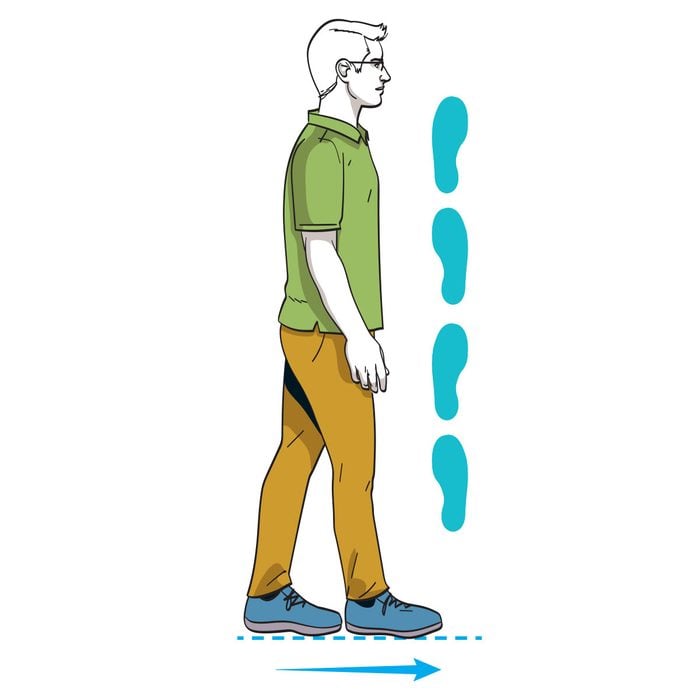
An Easy Exercise to Improve Balance
Tandem Walking
What is tandem walking?
Tandem walking is similar to the “walk and turn” sobriety test used by police officers. Place the heel of one foot directly in front of and touching the toes of the back foot. Begin walking heel to toe in a straight line, as if you are on a tightrope, and continue for 20 steps. Keep your eyes forward—no looking down at your feet. To increase difficulty, try tandem walking backwards.
Why it works
People’s sense of balance typically worsens with age, leading to falls, which can cause head trauma, hip fractures and other disabling injuries. “Regularly practising balance exercises, such as tandem walking or the tree pose in yoga—when done safely—improves concentration, coordination and balance,” says Erik Groessl, a professor of public health at the University of California, San Diego. “That’s important for maintaining mobility and preventing falls, not only for older adults but for everyone.”
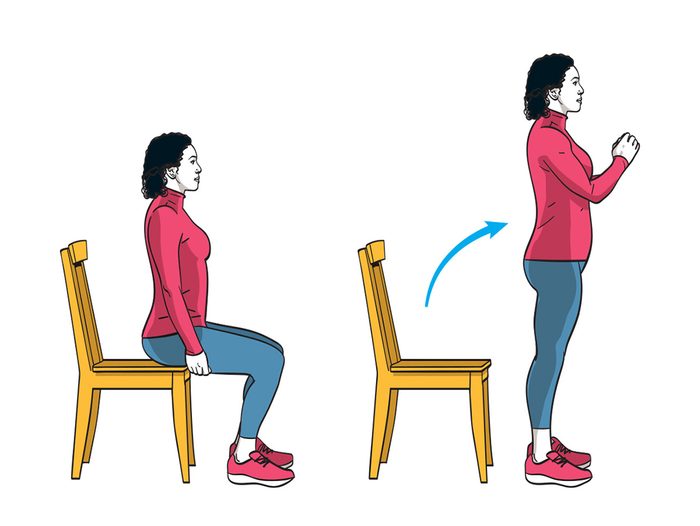
An Easy Exercise for Bone Health
Sit-to-Stand Manoeuvre
How to do it
Sit up tall in a sturdy chair (that won’t slide) with your feet shoulder width apart; move forward to the front of the chair. Place your feet so that your heels are slightly behind your knees. Hinge forward from the hips, keeping the spine long, and place your hands on your thighs. Stand up, putting equal weight through both legs. Sit down by hinging at the hips and lowering yourself with control. Keep your chest up throughout the exercise. Repeat 10 times. To further challenge yourself, you can place your arms across your chest, or use a shorter chair, or hold light weights in your hands while doing the exercise.
Why it works
Resistance exercises like this one strengthen the muscles and bones. “When you are contracting your muscles, you’re pulling on the bone, which stimulates bone growth. That’s why resistance exercises are particularly good for bone health and for preventing or managing osteoporosis,” explains Lindsay Duncan, a kinesiology professor at McGill University.
Find out if chair yoga is right for you.
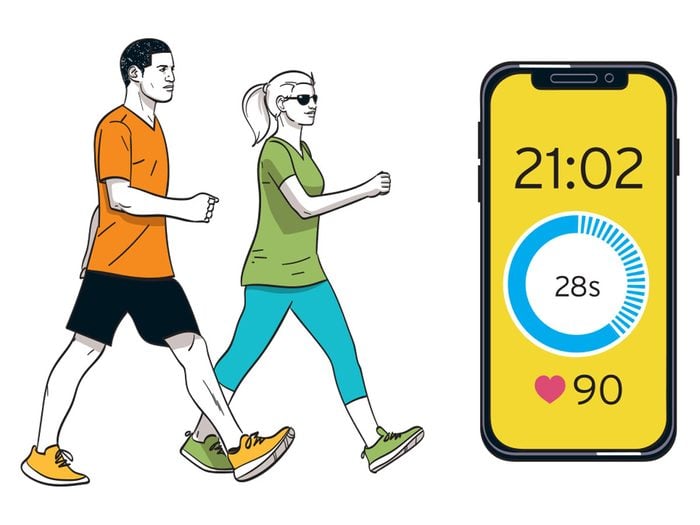
To Boost Your Brain Health, Try Interval Walking
What is interval walking?
Walk for five minutes at a moderate pace. Increase the intensity to a brisk walk for two minutes. Alternate longer periods of leisurely walking with shorter periods of brisk walking for a total of 30 minutes. How much you pick up the pace in the shorter intervals and for how long is up to you. Interval walking allows you to incorporate higher-intensity aerobic exercise into your work- out at your own pace.
You could start gradually—for example, by having just one or two short segments of brisk walking within a 30-minute period. Then you could work your way up to including more or longer segments of fast-paced walking, or even jogging.
Why it works
A McMaster University study found that sedentary older adults who went for interval walks significantly improved their memory. Also, in animal models, aerobic exercise has been shown to create new branches of blood vessels.
“This allows neurons to survive under adverse environments,” explains Teresa Liu-Ambrose, a professor in the department of physical therapy at the University of British Columbia. Brain growth can lead to improved memory, executive function and decision-making, among other things.
Liu-Ambrose’s studies have shown that aerobic exercise reduces cognitive decline in older women and men who have suffered mini-strokes.
Find out how the MIND Diet meal plan feeds your brain.
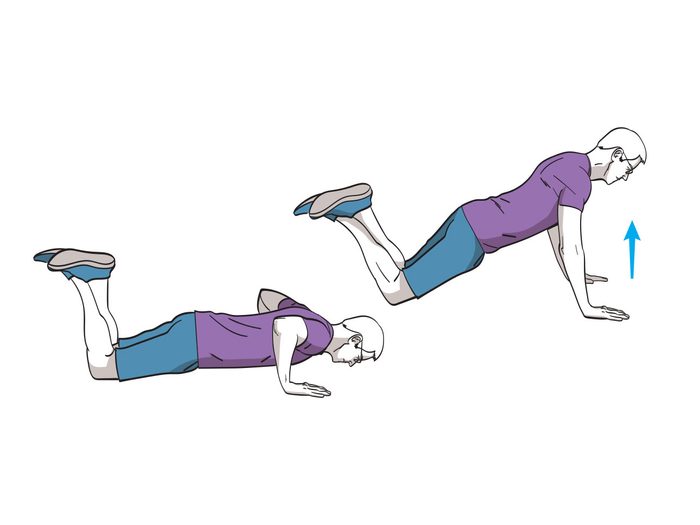
A Great Exercise for Preserving Muscle Mass
Kneeling Push-Ups
How to do kneeling push-ups
Start with your hands and knees on the floor, arms about shoulder width apart and extended. Your knees should be around hip width apart. Keep your back as straight as possible and your head in line with your spine. Inhale as you slowly lower your elbows to bring your chest toward the floor, keeping your core muscles contracted. Exhale as you push up from the floor to your starting position. Begin with a set of three or five repetitions and increase from there. Over time, work your way up to two sets of 10 repetitions.
Why they work
Around the age of 35, muscle mass begins to decrease at a rate of one to two per cent a year; muscle loss accelerates to three per cent a year after age 60.
A 2022 Danish study found that older men who were physically active and regularly did resistance exercise were protected against age-related muscle decline. These participants had more muscle stem cells, which are important for muscle regeneration and growth, and performed better on muscle-function tests than both younger and older sedentary adults. This study showed what others have also found: that doing 20 to 30 minutes of resistance training two to three consecutive days a week can increase muscle mass in adults of all ages. After three months, participants had lean-weight gains of about 1.4 kilograms.
Discover five daily habits to prevent muscle loss.
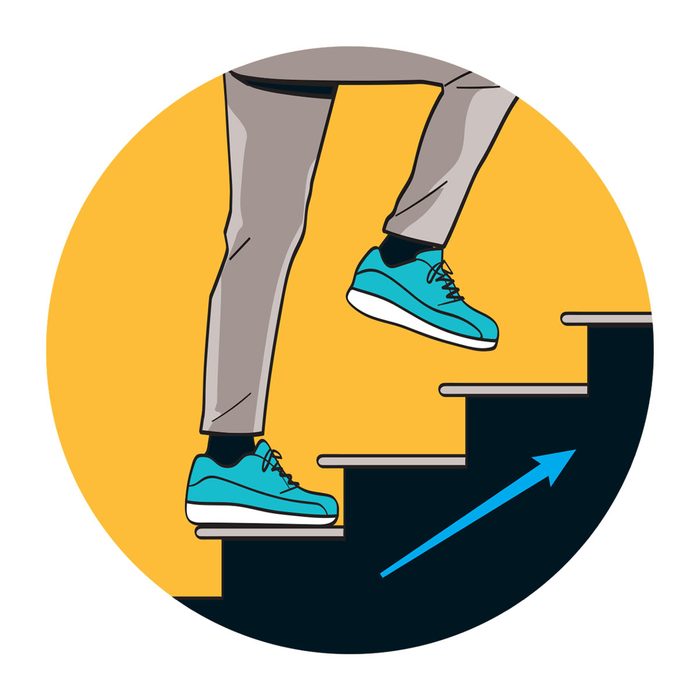
To Reverse Metabolic Syndrome, Try Stair Climbing
How to do it
Start slow and easy on the staircase, walking one step at a time to the top. Walk down slowly and pause at the bottom to recover before climbing again. Maintain good posture and wear running shoes with good cushioning and support. Control your breathing by counting to three each time you inhale and exhale, breathing through your nose and filling your belly, rather than doing shallow chest breathing. Gradually increase the intensity and duration of stair-climbing sessions as your fitness improves over time. Talk to your doctor before starting if you have heart disease, respiratory disease or joint problems.
Why it works
This is an efficient, low-impact cardio workout that engages more muscles than walking on a flat surface. A 2021 British study found that stair climbing is associated with improvements in blood lipids (cholesterol and triglycerides), abdominal weight, blood pressure and blood sugar—the four main risk factors for metabolic syndrome, which raises the risk of type 2 diabetes, heart disease and stroke. Stair climbing also strengthens leg muscles and joints and improves balance.
One reason why stair climbing is effective in lowering blood sugar is because it targets large muscles, including your quads, hamstrings, calves and glutes. “Muscles require energy when we exercise, and one source of energy is sugar from the bloodstream,” explains Jenna Gillen, a University of Toronto kinesiology professor.
Exercising larger muscle groups uses up more of that sugar. Gillen’s study, published in the Journal of Applied Physiology, showed that short exercise “snacks” of under three minutes every half-hour increased insulin sensitivity in healthy people who were inactive. (High insulin sensitivity allows the body’s cells to use glucose more effectively.)
Check out the latest research on how to beat diabetes.
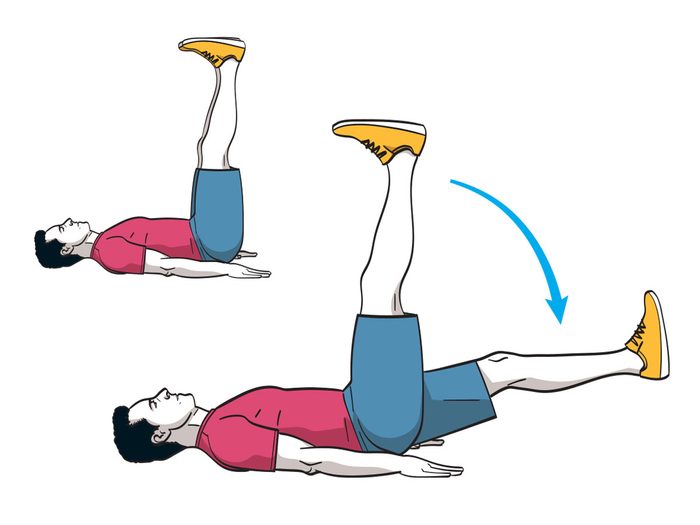
An Easy Exercise to Strengthen Your Core
Modified Flutter Kick
How to do a modified flutter kick
Lie on your back and place both arms at your sides, with your palms down, and extend your legs straight up to the sky, heels reaching up. Slowly lower one heel toward the floor, keeping that leg extended. Go as low as you can while keeping your back pressed to the floor. (If your back arches as you lower your leg, you’ve gone too low.) With control, bring your leg back up to the starting position. Switch legs. To make the movement easier, bend your knees. Try five movements per side, for 10 in total.
Why it works
Strengthening core muscles can improve posture, balance and stability and relieve strain on your back, helping to prevent or ease back pain. Strong core muscles also make it easier to do many physical activities, such as swinging a golf club or tennis racquet; doing housework that involves bending, lifting and twisting; reaching for an item from a top shelf; or sitting at a desk for several hours.
Here are the telltale signs you need to move more.
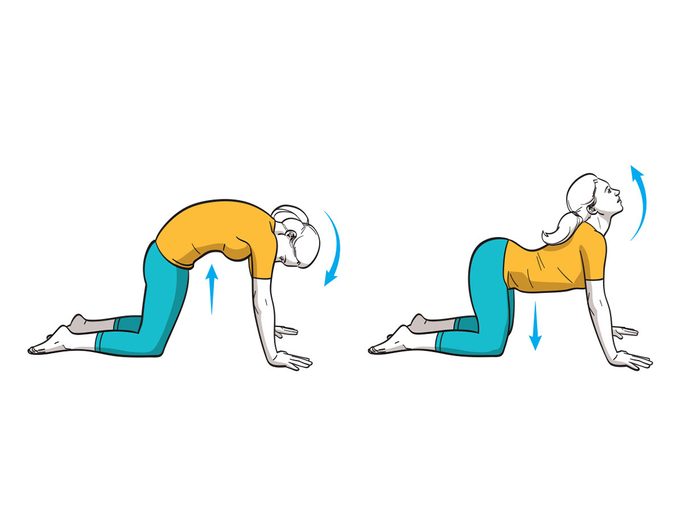
For Low-Back Pain, Try the Cat-Cow Pose
How to do the cat-cow pose
Begin the cat portion of this exercise by placing your hands and knees on the floor. Knees are under hips, hands under shoulders, and the spine is long and neutral. Engage your abs and inhale into the belly. On the exhale, round your spine, tailbone reaching down. Reach the top of your head down and let the back of your neck be long. On the inhale, move into the cow portion by sinking your belly toward the floor, reaching your tailbone up and chest forward as you gaze forward or slightly upward, without putting extra pressure on your neck. Flow from the cat to the cow pose for at least 10 rounds, inhaling for the cow and exhaling for the cat.
Why it works
While no single move will bring relief, says Susan Tupper of the Saskatchewan Health Authority, this one may help some people.
Yoga lengthens muscles such as the abdominals, obliques, hip extensors and hip flexors, and the movements help supply blood to the spinal discs. A 2017 study in the American Journal of Preventive Medicine found that low-back- pain sufferers in a 12-week yoga program had less pain and better quality of life than those who got standard care, such as meds, physical therapy and exercise.
“Cat-cow is a great warm-up pose that stretches and strengthens the deep small muscles in the area of the spine,” says Groessl. As with other yoga exercises, it can help to ease back pain. He adds that the deep breathing done in yoga relaxes the nervous system.
“There is solid evidence that yoga can improve mood and lower stress, which helps reduce the psychological aspects of pain.”
Check out 10 home remedies that are backed by science.
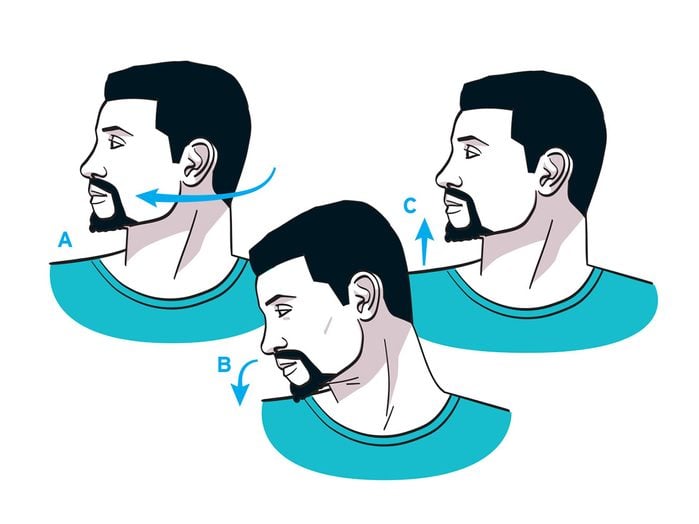
An Easy Exercise to Improve Flexibility
Neck Rotations
How to do neck rotations
When doing neck rotations, keep your shoulders and hips facing forward. Start by slowly rotating your neck to the right and gazing over your shoulder. To deepen the movement, gently press your chin toward your shoulder. Hold for up to 30 seconds and, alternating with rotations to the left, repeat the moves a few times.
Why they work
Neck tilts and rotations are important exercises in many warm-ups and, like all stretching exercises, aim to increase your flexibility and range of motion. Some exercise forms are more effective than others. A 2016 study in The Journal of Pain found that tai chi was as effective as neck exercises for treating chronic neck pain.
“Tai chi is brilliant at helping you establish proper alignment, and it relaxes your body so you can stretch better,” says Dr. Patricia Huston, an adjunct professor in the University of Ottawa’s faculty of medicine, whose research focuses on the role of exercise in a healthy lifestyle. “For neck rotations, you want to float the head and bring your shoulders down so you’re extending from the neck, which brings your body into alignment. You turn your head from side to side and it relaxes the muscles in the neck, easing the tension people carry in their neck and shoulders while sitting at a computer.”
Discover the easiest way to get a full-body workout from walking.
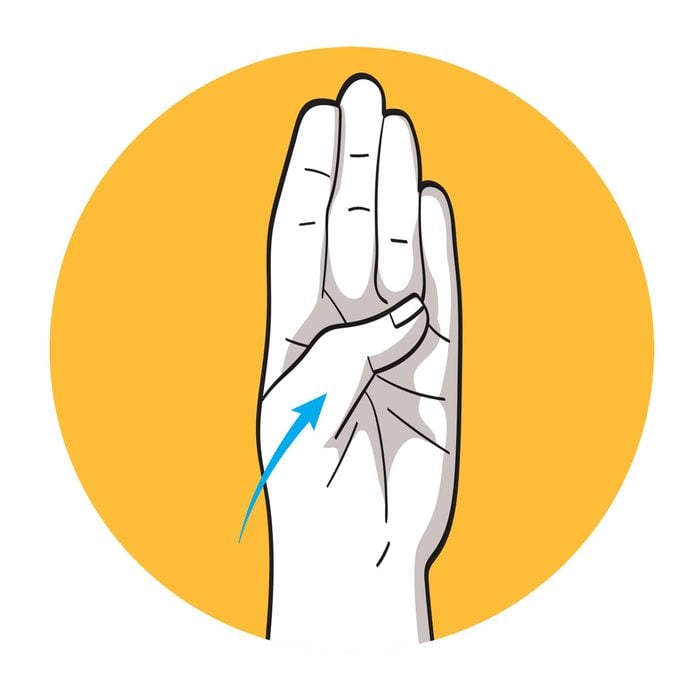
For Arthritis Relief, Try Finger Bends
How to do it
Hold your left arm straight out, with all your fingers straight, palm up. Bend your thumb slowly toward your palm, hold for a few seconds, then straighten. Repeat with all the fingers on your left hand, bending each and moving it to the centre of your palm, holding and then straightening. Repeat the entire sequence with your right hand.
Why it works
When osteoarthritis affects the joints of your hands or fingers, it can cause pain, stiffness, swelling, tenderness and weakness. Hand exercises—such as finger bends, finger lifts, finger slides and making a C, an O or a fist—and wrist bends are easy and can help relieve pain.
Hand exercises also strengthen the muscles that support your hands, helping you do any hand movements more comfortably. These exercises also increase production of the synovial fluid that helps protect and lubricate your joints. A 2014 Norwegian study found that women with arthritis who did hand exercises reduced hand-joint pain and improved grip strength and hand function.
Although it may seem counterintuitive to those with stiff and sore joints (for example, people with arthritis), exercise for your entire body is crucial to improve daily function. Physical activity strengthens the muscles and other tissues surrounding the joints, which are essential for supporting and easing stress on your bones. Plus, it strengthens your bones and helps combat fatigue.
Different types of exercise have different benefits: range-of-motion exercises reduce stiffness and increase your ability to move with less pain, or with no pain at all, and resistance exercises build stronger muscles to support and protect your joints. And keep in mind that low-impact exercise, such as walking, cycling or swimming, is easier on the joints.
Here’s what can happen when you start walking 10,000 steps a day.
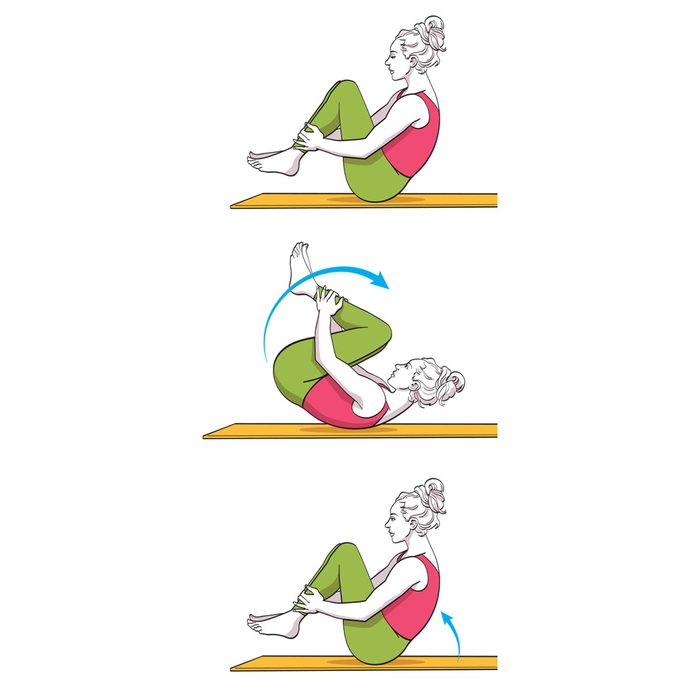
For a Healthy Spine, Try Rolling Like a Ball
(Note: This move is not for beginners)
How to do it
Sit on a yoga mat with your legs bent, toes pointed and knees pulled in toward your chest, then clasp your hands over your shins, just above the ankles. Drop your shoulders, widen your back, deepen the scoop of your abs and curve your spine in a C shape without tucking your chin. Lift your feet off the mat and balance on your sitting bones. Engaging your abdominal muscles, inhale as you roll backward to your shoulders (not all the way to your neck) and exhale as you immediately roll back up. Pause at the top, then repeat. Start with six repetitions.
Why it works
This classic Pilates exercise stimulates and massages the spine, which can relieve tension. It builds strength in the abdominals, while helping keep your spine healthy and flexible. A 2016 Spanish study found that an eight-week Pilates program is effective in improving disability, pain, flexibility and balance in patients with chronic low-back pain.
Next, check out more great exercises to relieve arthritis pain.